TOPOGRAPHIES OF SOLITARY HEAD SPACE Sophia Rohwetter on John Miller at Kunsthaus Glarus
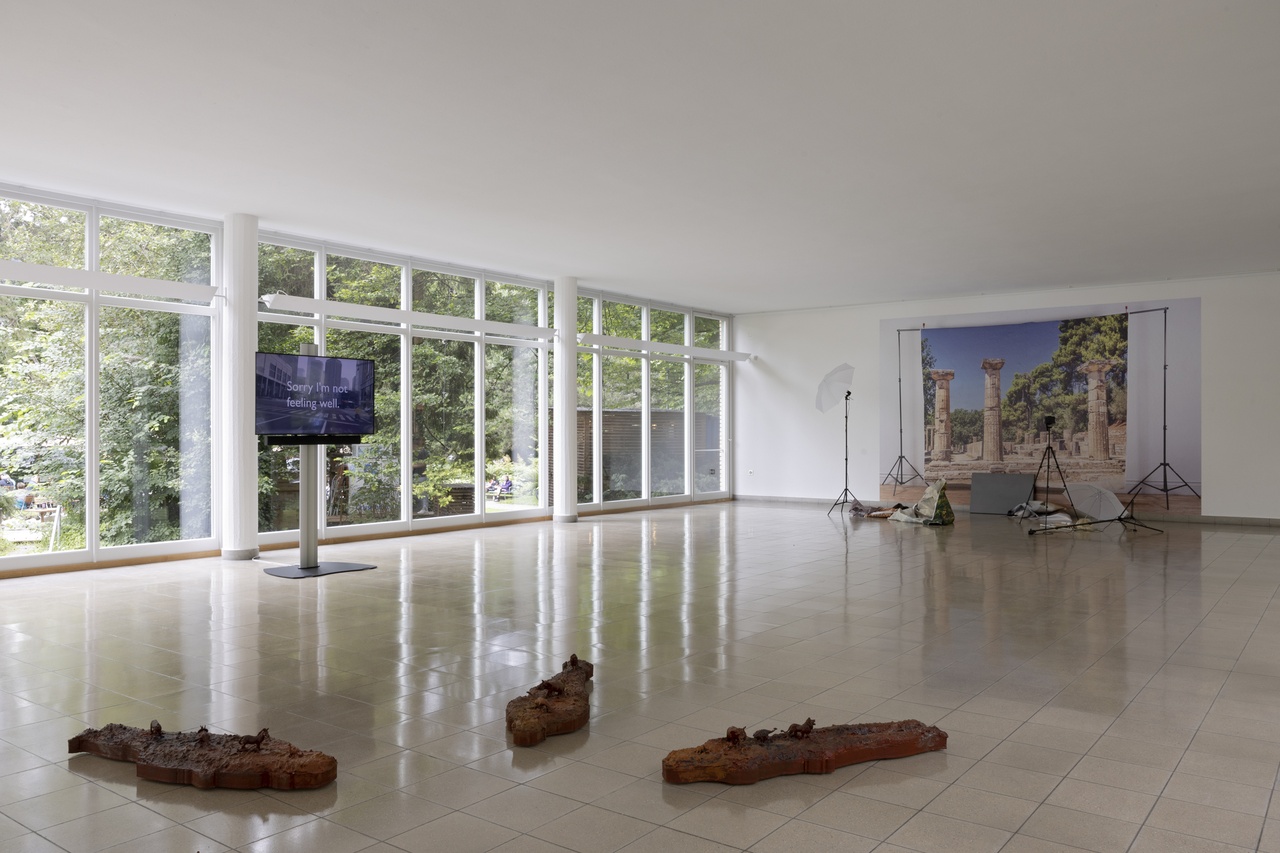
“John Miller: The Ruin of Exchange,” Kunsthaus Glarus, 2024
Dan Graham makes a funny face; his bespectacled nose wrinkled, brows furrowed, eyes narrowed, and mouth slightly opened inwards, as if asking: “Huh?” It is the first and perhaps only real face one encounters in John Miller’s exhibition “The Ruin of Exchange” at Kunsthaus Glarus, a condensed survey presenting works from 1994 to 2024 on the museum’s ground floor. Graham’s face, as seen from the left in profile, is screen-printed on cardboard, cut to the shape of his head and hung to the bright foyer’s yellow brick wall. The light shining in from the opposite, fully glazed wall falls flat on Graham’s cardboard face. Untitled (2013) is a multiple – produced for Veronica Gonzalez Peña’s rockypoint Press – and a collaboration: Graham’s head and idea, with a text written by Miller. [1]
This text, titled “Live in your head,” is displayed on the backside of the head-shaped postcard, that is, on Graham’s right profile. It follows – beginning with a poster on a phone booth and ending with these relics of untimely communication being torn down – an urban subject experiencing their “version of the city – no, the world,” one shaped by self-reflexive modern office towers, gridded abstractions and the “tyranny of T-squares.” Such general “hatred of architecture” is a recurrent theme in Miller’s work, recently addressed in an Essex Street exhibition on the vanishing of public space in New York’s Civic Center. At the height of Graham’s right eyebrow, the text provides a kind of phenomenological orientation to city life in an undefined but distinctly US metropolis, which might well be read like a post-Minimalist score directing the entering exhibition visitor: “I start to move toward something, and it’s there. My path is my body. I can already apprehend what was there.”
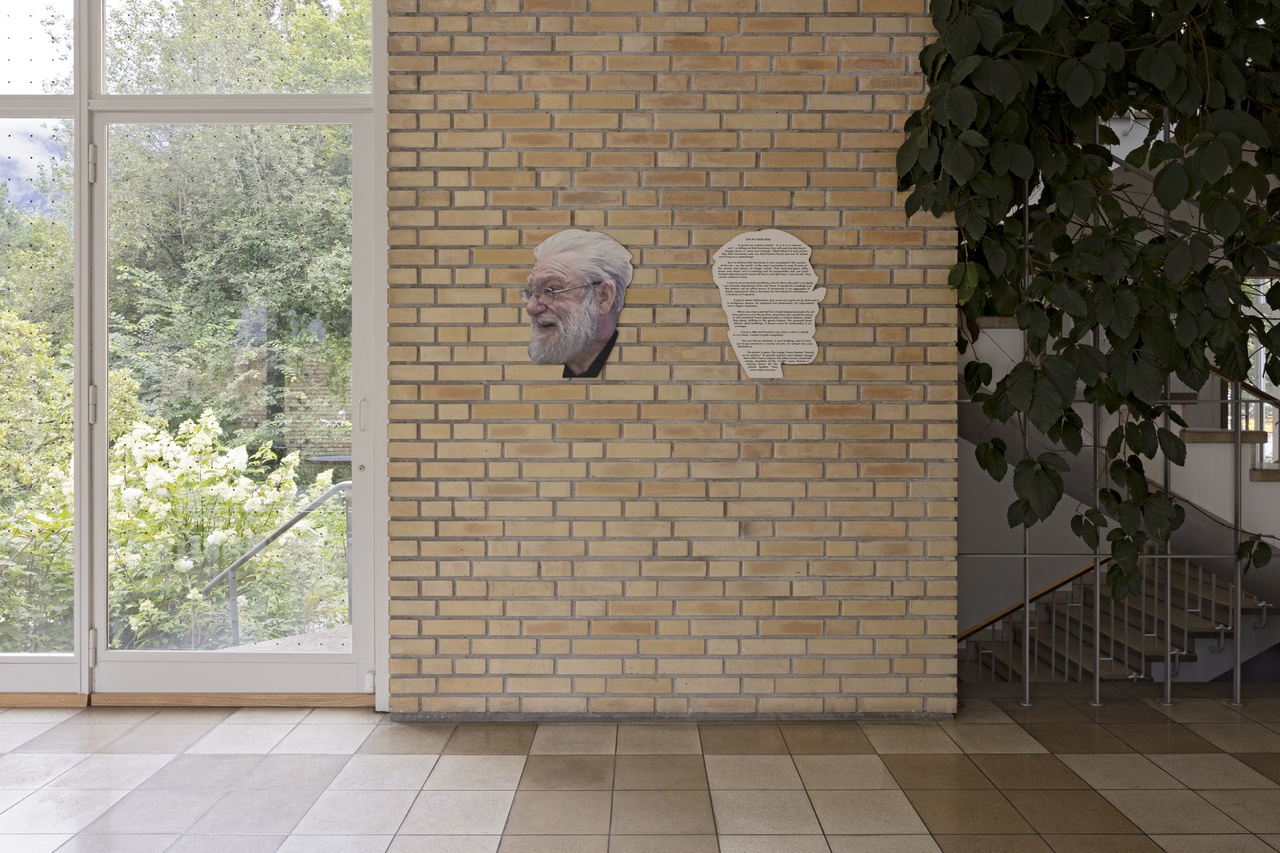
Dan Graham, “Untitled,” 2013
From “Double Dan,” [2] two ways lead to John. Following Graham’s left profile, one moves toward the “Oberlichtsaal,” which presents works from the past 30 years, including two mannequins created in collaboration with Richard Hoeck, eight paintings from the series Southwest Landscape Paintings (1994–96), a new series of what Miller calls trompe l’oeil paintings, [3] and two cuboidal mirror sculptures. Following Graham’s right profile, one walks toward the bright “Seitenlichtsaal,” which only showcases recent work, including the installations Epic Theater (2020) and Figure/Ground (2024), the music video Maybe Next Time (2024) produced with Takuji Kogo as part of their virtual band project ROBOT, and the poster The Ruin of Exchange (2024). The latter references Miller’s eponymous text from 2009, an equally poetic and algebraic manifesto on the relation between space, time, and exchange value in the capitalist present. [4] “Exchange happens in space” and “Money is the ultimate medium of exchange,” Miller reminds his readers – now his viewers. First, I head left toward the distant sight of a mannequin in plastic camouflage clothing, an automatic firearm leaning beside it against the wall (Camouflage on a Mannequin (Male Mannequin), 2008). As I approach the figure – its rouged, flashy face a mask like Graham’s cardboard one, yet vacuous and without a flipside – I see my lower legs, feet, and the tiled floor reflected in one of the mirror objects (Another Land, 2021). On top of the mirrored cube sits another, about the same width and depth and made of acrylic modeling clay covered in a thick pastose coat of the artist’s signature shit-brown acrylic paint known as John Miller Brown (JMB). The sculpture finds its inverse and shrunken version in Sunken World (2021). Depending on where I stand, my feet seem to sink deeper into the doubled image of the floor or to disappear altogether – “I see myself, then vanish without a trace,” I remember a line from Graham’s head. From certain positions, the mirrors reflect details of the images on the walls: margins of trompe l’oeil cityscapes; edges of generic Americana landscapes based on found photographs; fragments of a light blue color field, not quite an International Klein Blue (IKB). A child mannequin in oversized clothes is contemplating this wall painting at close distance, like a Rückenfigur staring out at the image of the open sea. Sunken World and Another Land – colonial-cowboy-sci-fi titles suggesting a melancholic attachment to places fallen, stolen, lost, and found – both orient and disorient the viewer (at least me, and I’m the only one here during my 3.5-hour visit) as their reflections multiply and displace the space while simultaneously capturing it as image. My path is my body, and I am already lost.
But the familiar sight of urban surfaces on the gallery’s left wall – shop windows, spray-painted facades, posters peeling off signboards – in the metropolises of Berlin, Seoul, and New York keep me grounded. A photograph of a tourist store decked out in national flags – and where a “Hawaiian” necklace in the German national colors, keffiyehs (a symbol of Palestinian liberation increasingly criminalized by racist German authorities), and printed tees picturing the illuminated Brandenburg Gate or pseudo-Native Americans who are both exotified and sexualized are for sale – feels like a dead-on detail of the everyday perversions of global racial capitalism (Media-Saturated Eyes, 2023). The shallow facade of a sports betting office luring in visitors with an anamorphic image of the “Meisterschale” forever out of reach (Yearning for Quill Pants and Candles, 2023), alongside a cropped advertisement pasted onto a panel on a roughcast wall depicting the lonely joy of a woman playing mahjong on a digital device, her face contorted in a Graham-like expression (Domestic Bric-à-Brac, 2023), appear as a formal play on the solitary social world of pathological gambling; or, as the title of another work of the series – a fashion ad partly hidden behind weathered, peeling quasi-AbEx posters – suggests, as an urban “momento mori.”
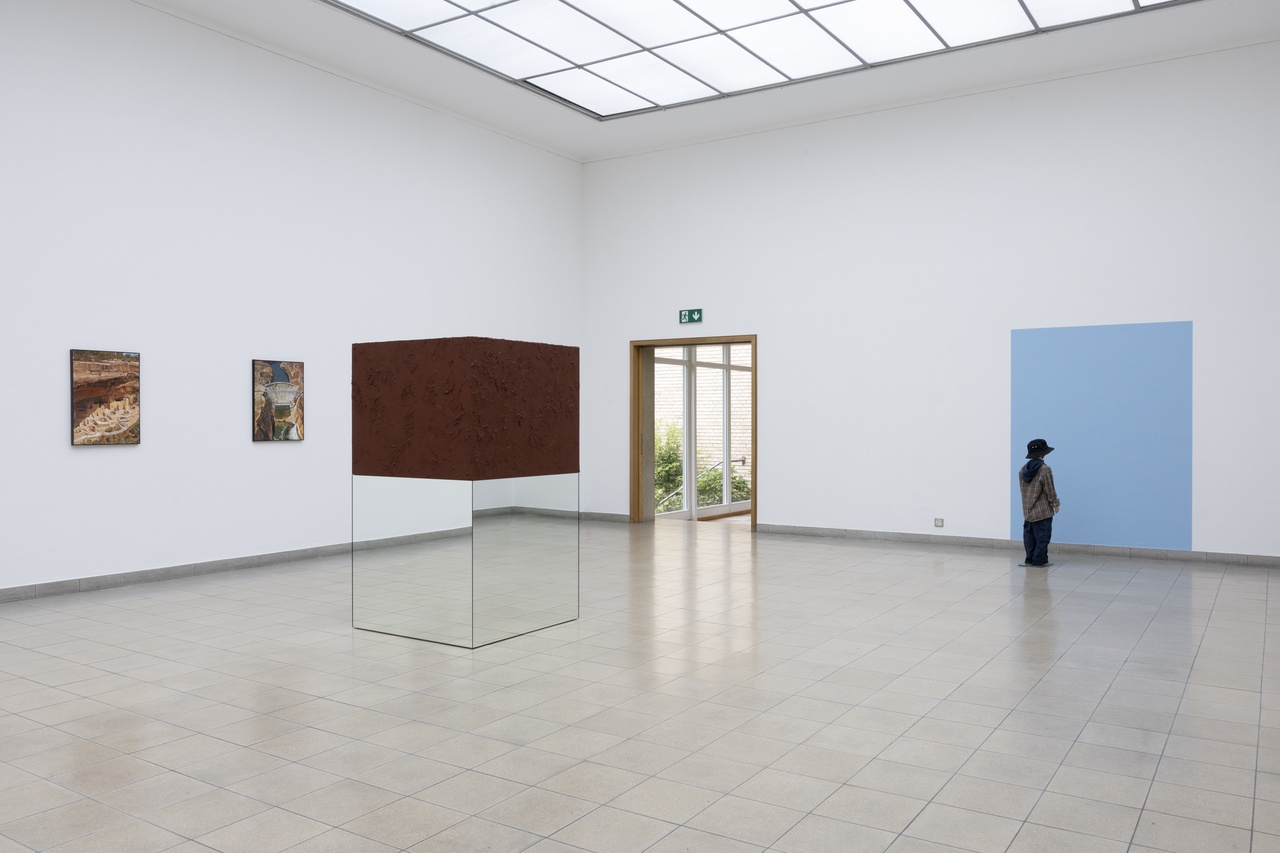
“John Miller: The Ruin of Exchange,” Kunsthaus Glarus, 2024
Miller refers to these images, which borrow their titles from texts on the painting technique, as trompe l’oeil paintings, because their flat picture surfaces are fooled by painted elements: brown impasto squares and rectangles mixed with jets of yellow ochre, red, and blue hover over the surficial cityscapes. But while strangely detached from space and time, these forms cast a solid artificial drop shadow on the otherwise flat photographs, thereby adding to a feeling of realistic perspective depth while simultaneously subtracting the realism of the photographic medium. “It’s a trick, deliberately done,” Miller explains in an interview accompanying the show; he then goes on to relate this gimmick to the short-lived genre of Abstract Illusionism. In 1967 Barbara Rose coined the term to describe a trend in abstract painting of the 1960s circling back to illusionist devices, often using two-point perspective or simulated cast shadows. If the return of illusionism was situated, as Rose claimed, within a broader shift from “the acknowledgment of the flatness of the picture” toward “the acknowledgment of the inescapable illusionism of pictorial space” [5] at the time, it differed from trompe l’oeil in that it didn’t aim at fooling the eye but seeing through the artificiality of the pictorial space. Against this backdrop, Miller’s surficial cityscapes combine Abstract Illusionism’s self-conscious production of artificial pictorial depth with the deceptive function of trompe l’oeil’s realism to create something like a trompe l’oeil interpretation of synthetic cubist montage. But these are not, or not only, paintings about painting. As the JMB shadow-throwing forms reflect and refer back to the brown cubes in the middle of the gallery, they spill over into the third dimension to objects in real, albeit visually manipulated, space. Thus painting has already moved beyond itself, toward the exchange happening in space.
JMB, as a shitty color code and a sort of master signifier, represents the economic law of exchange and equivalence in psychoanalytic terms, as Sigmund Freud claimed a symbolic equation between “faeces (money, gift), baby and penis,” arguing that, in the productions of the unconscious, these concepts are “ill-distinguished from one another [and] easily interchangeable.” [6] According to Freud, the child’s conception of money originates from the understanding of feces as gift, an object of value that it can either give or withhold from its parents. “It is probable that the first meaning which a child’s interest in faeces develops is that of ‘gift’ rather than ‘gold’ or ‘money’ […]. Since his faeces are his first gift, the child easily transfers his interest from that substance to the new one which he comes across as the most valuable gift in life.” Shit, like money, is a token or object of exchange – by now, this is something of a John-Miller-truism, often repeated and impossible to disavow.
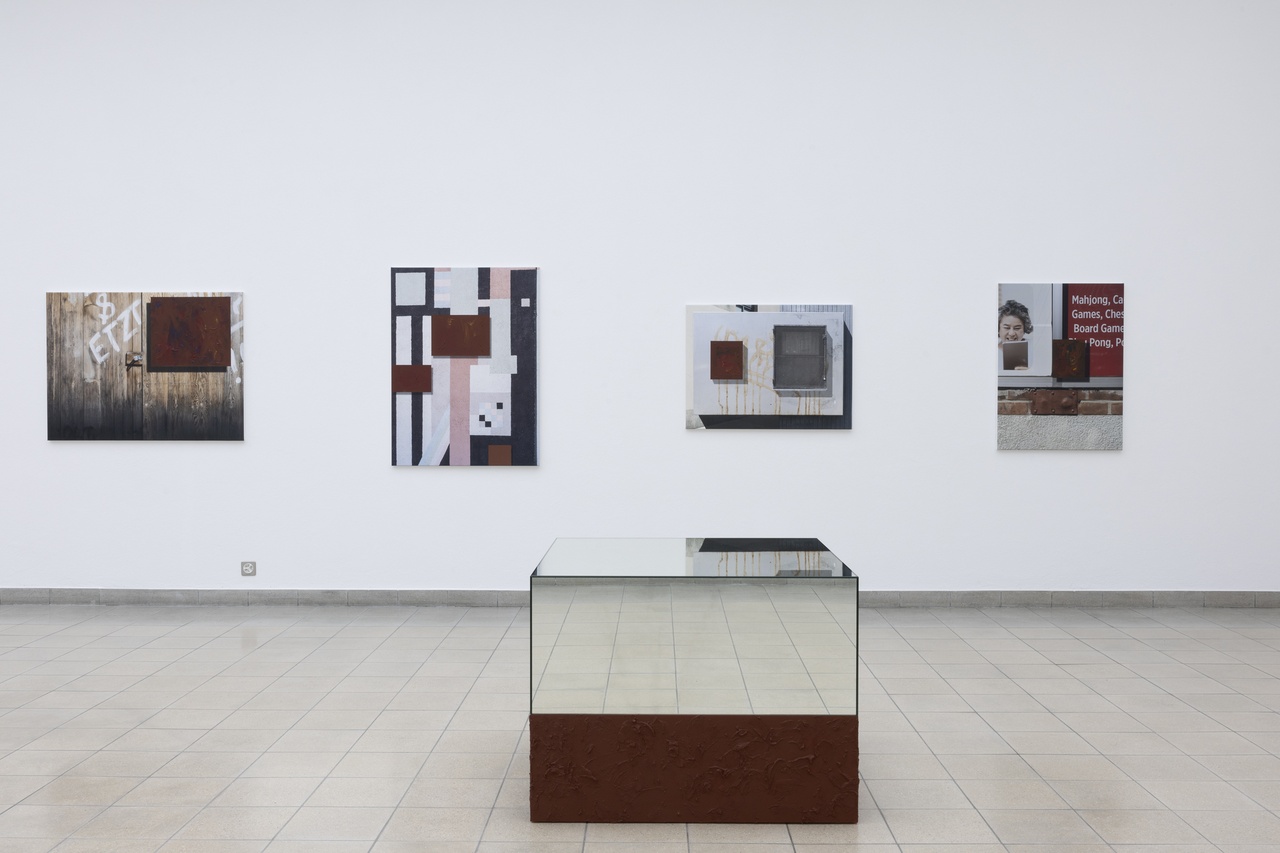
“John Miller: The Ruin of Exchange,” Kunsthaus Glarus, 2024
But what else happens in this scatological space, this ruin of exchange? For Miller, the site is a matter of allegory in the Benjaminian sense: the melancholic image of the city as ruin, a spatialization of the temporal structure of a world experienced as no longer permanent. This allegorical path continues in the opposing gallery, the “Seitenlichtsaal.” Here, framed by the aphorisms on the poster, a constellation of allegorical ruins forms around a landscape made up of five star-aligned silhouettes of strangers Miller photographed on street corners and later modelled with Styrofoam and plaster tape. These abstracted and distorted figures build the earthy ground for a time-layered archeological site populated by dinosaurs and other miniature animals, all painted in JMB (Figure/Ground, 2024). Behind it, a Brechtian photo studio set features a scattered arrangement of equipment and props against the backdrop of an ancient temple (Epic Theater, 2020), including alternative folded background images, lighting and camera stands, fabric, a wig, and a mannequin’s hand and foot. The scenery is underscored by the artificially sad sound and tragicomic lyrics of ROBOT’s music video Maybe Next Time: “Someone stole my phone; I’m here alone. My car broke down, and I can’t get home. My pet is not feeling well. And you look like my mother.” Not so lame excuses of a subject caught in a social world but wanting to be left alone. The video, its footage found online, follows the deserted streets of Beijing at a slow, rhythmic pace, with only a few cars, bikes, and pedestrians passing by, evoking memories of the ghost towns of pandemic times. Facing one of the gallery’s glassed sidewalls marked with a grid of small black dots to fend off disoriented birds, I watch the video. My gaze wanders off to a few people sitting in the park café behind the museum, but no one looks at me, no one ever looks in here. These ruins are lonely, and this is Glarus – a Swiss non-place, “an ideological non-site” [7] at the foot of the 2,300-meter-high Vorderglärnisch, tinged by the absence of its once important textile industry. Who comes here for an exchange in space, in ruins – except some mannequins tired of promoting commodities who turn away from the customer/viewer, hide in camouflage to remain uncannily present, or disintegrate into partial body parts? No one while I was there – and I was only there because the magazine asked me to go and the curator paid for my ticket (on the condition that these lines get published).
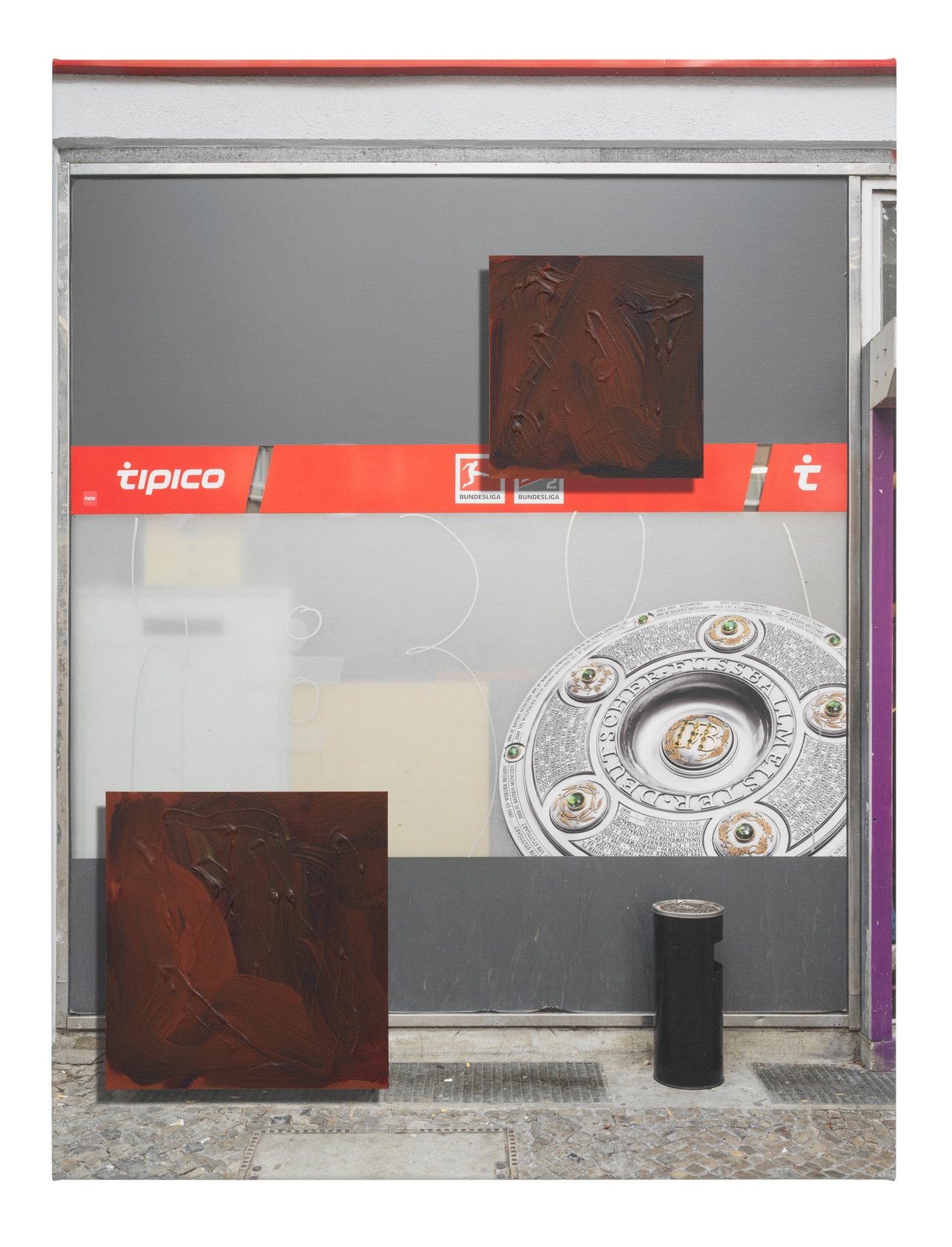
John Miller, “Yearning for Quill Pants and Candles,” 2023
In his obituary to Dan Graham, published in this magazine a few days after Graham’s death in February 2022, John Miller emphasized the role of the temporal-spatial experience of the viewer in Graham’s work, writing that it is “the presentness of the spectator” that is the point of Performer/Audience/Mirror (1977). [8] But here, in Miller’s show in Glarus, there is no performer, an audience of one, and two mirrors covered in shit, yet it is indeed my own presentness in the here and now that constitutes my experience of this exhibition, namely one determined by the absence of others in this space. It is an interesting experience, subjective and corporeal, yet consciously determined by Miller’s spatial play, in which he is present as an actor in absentia. But still, there remains a slight feeling of disappointment: I always thought John Miller’s work was fun, but without anyone here to laugh with, it’s just me, projecting against the funny faces of Double Dan.
“John Miller: The Ruin of Exchange” at Kunsthaus Glarus, July 14–November 24, 2024.
Sophia Rohwetter is an art historian and writer based in Vienna.
Images credits: 1. + 3. + 4.: Courtesy Galerie Johann Widauer, Innsbruck and the artist, Photo: Gina Folly; 2. Courtesy of the the artists, rockypoint Press and Veronica Gonzalez, Photo: Gina Folly; 5. Courtesy Trautwein Herleth, Berlin and the artist, Photo: Trautwein Herleth, Berlin
Notes
| [1] | Miller recounts the production of the piece in a short text published in October in 2022, shortly after Graham’s passing, explaining that “around 2009, Dan Graham invited me to write a text for a multiple he wanted to make with rockypoint Press. […] The multiple was to be a self-portrait, inspired by picture postcards of Princess Diana that Dan had seen in London. These were no ordinary postcards. They were cutouts, cut to the shape of Diana’s head.” John Miller, “Double Dan,” October, no. 180 (Spring 2022): 126–30, at 127. On the making of “Double Dan,” see also the interview with John Miller conducted by Kunsthaus Glarus’s director and curator of the exhibition, Melanie Ohnemus, https://kunsthausglarus.ch/assets/Uploads/KG-heft-14-978-3-906538-43-3-VIEW.pdf. |
| [2] | See Miller, “Double Dan,” 126–30. |
| [3] | See the interview with Miller conducted by Ohnemus. |
| [4] | Miller first used the title “The Ruin of Exchange” for a series of PowerPoint works on public space, then for a book of collected writings and criticism, and now for a poster and an exhibition. |
| [5] | Barbara Rose, “Abstract Illusionism,” Artforum 6, no. 2 (October 1967): 33–37, at 33. |
| [6] | Sigmund Freud, “On Transformations of Instinct as Exemplified in Anal Erotism” [1917], in The Standard Edition of the Complete Psychological Works of Sigmund Freud, vol. 17, An Infantile Neurosis and Other Works (1917–1919), ed. James Strachey (London: Hogarth, 1955), 125–35. On the psychoanalytic play on the symbolic interchange between feces, money, gifts, babies, and penises in the work of John Miller (and Mike Kelley), see, e.g., Hal Foster, “Obscene, Abject, Traumatic,” October, no. 78 (Fall 1996): 107–24. |
| [7] | John Miller in conversation with Beatrix Ruf, in A Refusal to Accept Limits, ed. Beatrix Ruf, Kunsthalle Zürich (Zurich: JRP|Ringier, 2010), 25. |
| [8] | John Miller, “Dan Graham (1942–2022),” Texte zur Kunst, no. 126 (June 2022): 236–237, at 236. |
